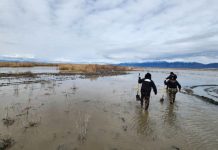
DENVER, April 20 (UPI) — Monarch butterflies expected to appear in the Midwest and northeastern United States in the next few weeks can expect help with their habitats this year along U.S. highways, railroad embankments and electrical corridors.
Now that the U.S. Fish and Wildlife Service is considering listing the monarch as protected under the Endangered Species Act, transportation agencies, railroads and energy companies have agreed to create monarch-friendly habitats for the butterflies and other pollinators on millions of acres of rights-of-way.
“It’s not that big of a lift [to convert rights-of-way] since transportation agencies and energy companies are already managing vegetation,” said Iris Caldwell, project manager in the Energy Resources Group at the University of Illinois-Chicago.
Caldwell and the Rights-of-Way as Habitat Working Group helped the federal wildlife agency coordinate the wildlife service’s agreement, released earlier this month.
Cooperating agencies and organizations will receive special federal waivers on future permits and licenses if the butterfly is listed as endangered, as long as they make changes now to provide butterfly habitat, the Candidate Conservation Agreement with Assurances says.
Populations of monarchs have diminished, dropping by 80 percent from an estimated 1 billion in the 1990s to 200 million in 2018 for the migrating monarchs that travel thousands of miles from the U.S. Midwest to Mexico, according to a 2019 study by the Portland, Ore.,-based Xerces Society for Invertebrate Conservation.
The situation was more dire for another group that migrates along the Pacific Coast, which has dropped by 98 percent from 1.2 million in the 1990s to just 30,000 in 2018.
During the 2019-2020 wintering season, the area of Mexican forest occupied by monarch butterflies was 7 acres, down from 15 acres in the 2018-2019 season, according to the World Wildlife Fund.
The monarch habitat has been declining in the United States, said Laura Lukens, national monitoring coordinator for the St. Paul, Minn.,-based Monarch Joint Venture, a non-profit monarch advocacy group.
“There are lots of factors and threats the monarchs face, and habitat loss is a big one,” Lukens said.
“We’ve lost a lot of milkweed from the landscape, and native prairie isn’t there as it used to be. But there are millions of acres along roadsides in the U.S. that can contribute to bringing native habitat back,” she said.
Highway departments, such as the Delaware Department of Transportation are planting roadways with milkweed, on which monarchs lay their eggs.
Caterpillars eat leaves, stems and flowers before creating a chrysalis. When the butterflies emerge, they gain energy from other nectar flowers, like the wildflowers planted beneath power line corridors in Ohio by FirstEnergy.
“By removing uncertainty and creating habitats, [this agreement] encourages a place for monarch butterflies and will hopefully eliminate their need to be listed on the Endangered Species Act,” said Melissa Savage, director of the Washington, D.C.,-based American Association of State Highway Transportation Officials Center for Environmental Excellence.
That will save time and money for future transportation projects, she said.
This year’s monarch butterflies started their generations-long journey clumped together in cool, moist forests 10,000 feet above sea level in central Mexico.
In February, the butterflies begin their flights north, said Ellen Sharp, who runs the non-profit Butterflies & Their People, near the Cerro Pelon Monarch Butterfly Sanctuary in central Mexico.
“Suddenly, the trees turn orange and they all flap their wings in the sun and start to fly,” Sharp said. “There’s a sound like running water or rain on a roof. It’s magical.”
The Mexican butterflies fly from central Mexico north to the “Texas Funnel” near San Antonio where they lay eggs, reproduce and die. Scientists tracking the monarchs with isotope studies can determine where they hatched.
By early April, a second generation has traveled farther north, roughly along Interstate 35 through Oklahoma, Kansas and Missouri, according to the citizen online butterfly tracker Journey North.
It’s the third “super generation” born in the northern U.S. states and Canada that makes the 2,500-mile autumn trek, flying at 5 mph back to Mexico, said Karen Kinkead, wildlife diversity program coordinator at the Iowa Department of Natural Resources.
To give insects the strength for their momentous journey, a nectar-rich habitat of flowering native plants all summer is crucial to the monarch — and it also benefits other pollinators, too, Kinkead said.
“If you build it they will come,” she said. “Even a small patch of flowers in a yard or planters on a deck can help. It’s unusual that a wildlife species can be helped on a large scale by actions in small areas.”






